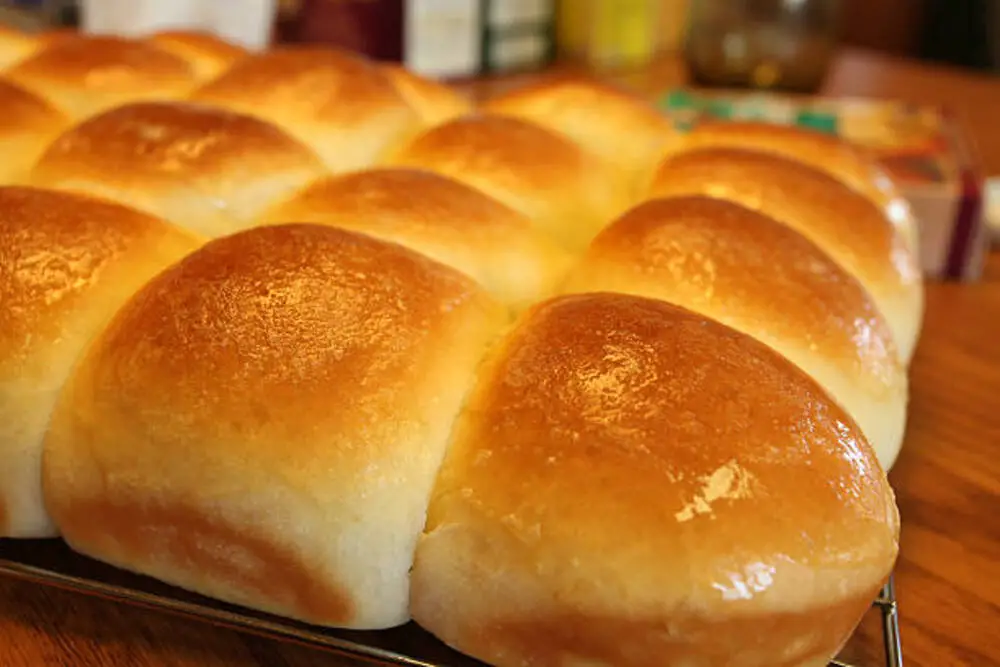
Sourdough Milk Buns Recipe
These Sourdough Milk Buns are soft, fluffy, and slightly sweet. Perfect for breakfast, lunch, or dinner, they pair beautifully with various spreads and toppings, making them a versatile and delicious addition to any meal.
Print
Pin
Servings: 9 buns
Ingredients
For the Tangzhong
- 100 ml 1/3 cup plus 1 tablespoon milk
- 2 tablespoons strong white bread flour
For the Japanese Milk Bread Dough
- 350 g 2 1/3 cups strong white bread flour
- 55 g 1/4 cup caster sugar
- 3 g 1 teaspoon instant dried yeast
- 1 egg
- 1 teaspoon fine salt
- 125 ml 1/2 cup milk, warmed to 37°C/98°F
- 50 g 1/2 stick unsalted butter, softened
For the Eggwash
- 1 egg
- 1 tablespoon milk
Instructions
For the Tangzhong
- In a small saucepan, whisk together the flour and milk until smooth.
- Heat the mixture over low heat, continuously whisking.
- Keep whisking until it thickens into a paste with visible lines when whisked.
- Transfer the thick paste to a small bowl and allow it to cool.
To Make the Dough
- In the bowl of a stand mixer, combine the flour, yeast, salt, and sugar.
- Using a dough hook, mix the dry ingredients thoroughly.
- Add the egg and the cooled Tangzhong.
- Gradually pour in the milk, mixing until a sticky dough forms.
- Incorporate the butter, one tablespoon at a time, ensuring each piece is fully blended before adding the next.
- Knead the dough on medium speed for 10-15 minutes, until it passes the windowpane test and pulls away from the sides of the bowl.
- Lightly oil a clean mixing bowl.
- Shape the dough into a smooth ball and place it in the oiled bowl.
- Cover with a tea towel or bowl cover and let it rise in a warm place for about 1.5 hours, until doubled in size.
Portion the Dough
- Gently deflate the dough as you remove it from the bowl.
- Divide the dough into 9 equal portions, using a digital scale for accuracy.
Shaping the Dough
- Line a square baking pan with parchment paper.
- Shape each piece into a smooth ball by pulling the edges into the center and pinching them together.
- Place the shaped buns in the prepared pan.
- Repeat with the remaining dough pieces.
Proving the Shaped Dough
- Cover the pan with a clean tea towel and let it rest in a warm place for about 30 minutes, until the buns are nearly doubled in size and touching each other.
Baking the Japanese Milk Buns
- Preheat the oven to 180°C/356°F and place a metal baking tray on the middle shelf.
- Lightly brush the buns with the egg wash.
- Bake for 20-25 minutes, checking at 10-15 minutes. If browning too quickly, cover loosely with foil.
- The buns are ready when an internal temperature of 85°C/185°F is reached.
- Allow the buns to cool in the pan for 5 minutes before transferring to a wire rack to cool completely.
Notes
Windowpane Test Pinch off a small piece of dough, roll it into a ball, and gently stretch it. If it forms a thin, almost translucent sheet, your dough has passed the "windowpane test," indicating sufficient kneading and readiness for proofing.
Make Ahead Tips Prepare the dough as per the recipe, cover it, and refrigerate overnight or for 8-10 hours. The dough should double in size. Proceed with the recipe the next day, allowing extra time for the second proofing.
Different Types of Flour For Swiss readers: Use Zopfmehl (or farine pour tresse) for bread and enriched dough.
Different Types of Yeast
- Instant Yeast: Can be added directly to the flour mixture.
- Dried Yeast: Must be activated in warm liquid first. Check the packaging for instructions.
- In the oven with the light on.
- In the oven with a tray of boiling water.
- In the oven at 25-30°C (77-86°F).